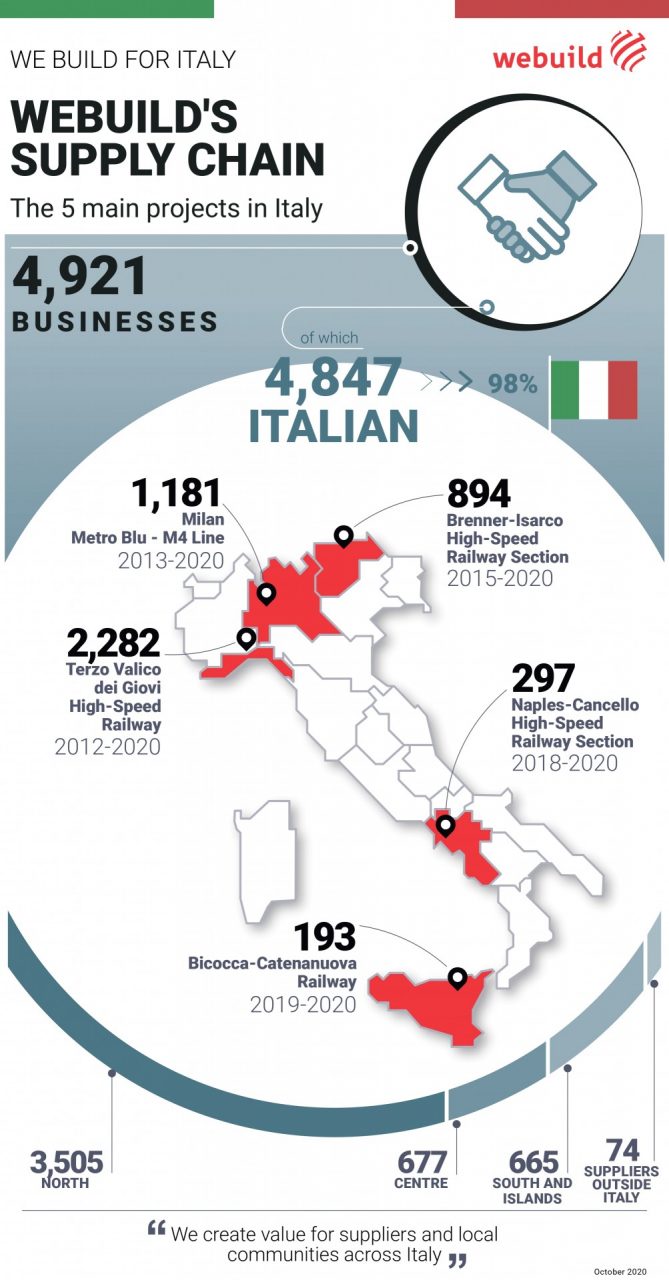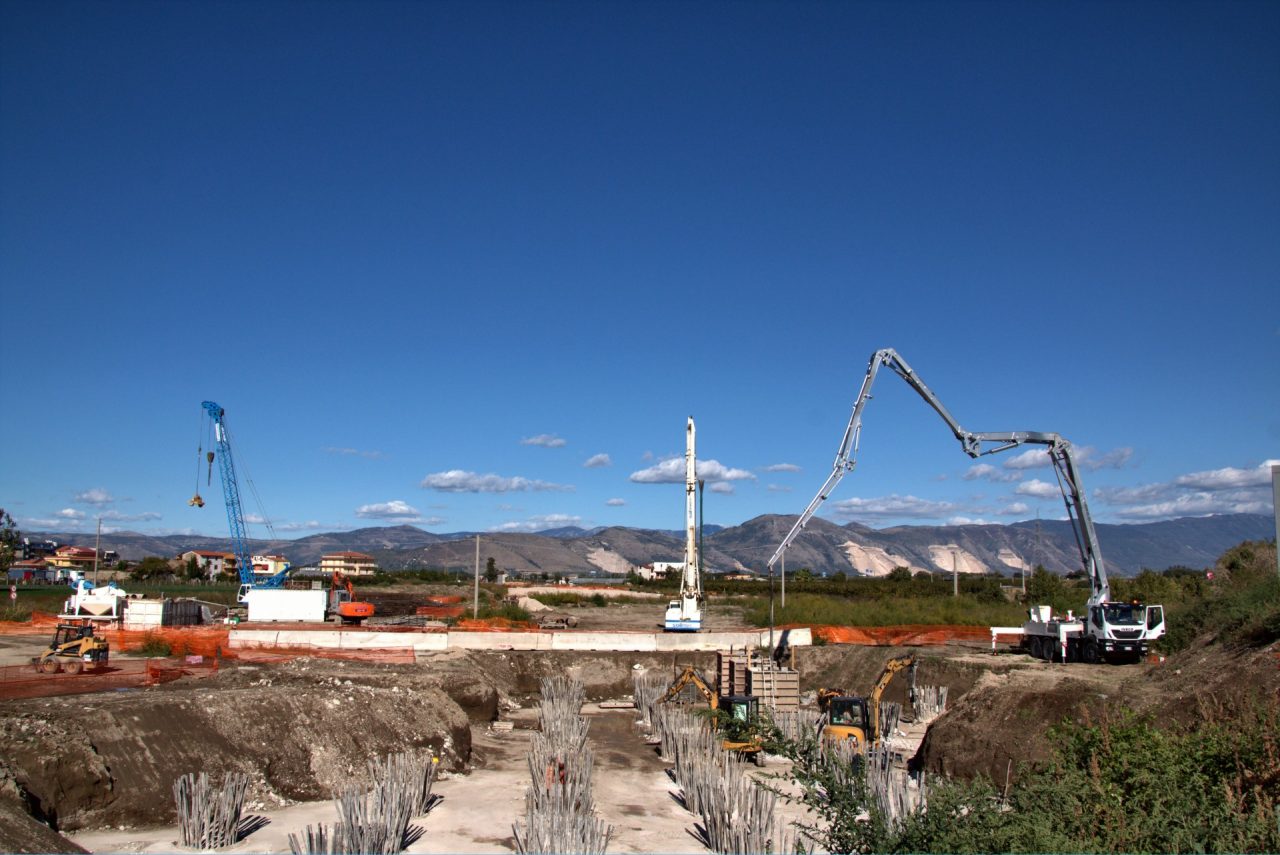From Trentino Alto Adige to Sicily, from Campania to Liguria, from Calabria to Lombardy. The story of Italy’s “Big Five” new infrastructure projects is the story of the 5,000 contractors and suppliers working side by side with the Webuild Group. A story of expertise, but also of job creation, transforming these worksites into a unique opportunity to create new opportunities even in areas where jobs are often scarce.
The Brenner Base Tunnel, Europe’s longest underground railway route once completed; the Naples-Bari high-speed train line; the Bicocca-Catenanuova line, which will double the speed of trains between Catania and Palermo; the Terzo Valico dei Giovi mountain tunnel for the bullet train connecting Genoa and Milan; and last but not least Milan’s new subway the M4, where tunneling machines continued throughout the lockdown to build a fast and sustainable connection between Linate airport and the center of Italy’s business capital.
To build these five major projects where the Webuild Group is leader of the construction consortia, it has mobilised an extensive supply chain: a total of 5,000 companies (4,921 to be precise). The total value of contracts reaches €4.4 billion. These numbers give a clear picture of the complex world revolving around a construction site where work, excellence, innovation, and organisational capacity are all essential elements.
The supply chain: the engine of sustainable works
The supply chain of the large infrastructures in Italy has an Italian soul. In fact, 98% of the companies involved (4,847 of the total) are Italian companies, which is testimony to a sector that — despite bureaucratic delays, stalled construction sites, the slowness of many tenders — is able to respond in real time to any emergency by offering high quality services, innovative technologies, patents designed to be used on site and on the job. And of course, specialised personnel, consisting of engineers, technicians, and workers, who have come back to Italy after traveling the world.
Sustainability is always at the center of this “army” of engineering and production talent. Four of these five projects are high-speed or high-capacity railway lines, the so-called “European metro” supported by the European Union and included in the TEN-T project for high-speed rail networks to connect the continent from one end to the other. The fifth project (Milan’s M4 subway) is a driverless underground public transport line that will connect the Linate airport with the city center in just 15 minutes.
All these projects involve sustainable mobility, essential to reduce CO2 emissions into the environment and at the same time significantly reduce road congestion.
Webuild Group is the common denominator, but behind all of these projects is the strength and expertise of the Italian supply chain, thousands of companies from all over the peninsula and strong both on the domestic and international markets.
The supply chain champions
It’s hard to capture the complexity of expertise found at the 5,000 companies involved in these five major worksites.
From the excavation of wells to the waterproofing of tunnels, from geological analysis to soil consolidation, from waste management to the transport of manufactured products, the galaxy of companies is boundless and reaches all across Italy.
On the Napoli-Bari worksite, the Fagioli company (which was involved in transporting the spans of the new Ponte San Giorgio in Genoa) will manage the handling and installation of pieces weighing 2,500 tons each.
“Like we did in Genoa, we load the piece at the prefabrication site, position it, and lift it with hydraulic jacks,” says Fabio Belli, Fagioli’s managing director.
These sites with a high degree of technical and organisational complexity all seem deceptively simple. But managing abandoned waste, in an area like Afragola (where the Naples-Bari line is being built), is very complex. This is the task of F.lli Gentile srl, a company specialized in environmental protection at construction sites.
“We handle reclamation of the soil, subsoil and groundwater,” explains Giovanni Gentile, managing director of the company. “As part of this work, the removal of waste abandoned in situ represents the first step, and is carried out on the basis of analytical assessments to find the most appropriate and effective technique of removal, transport and disposal.”
In Sicily, where Webuild is building the Bicocca-Catenanuova train line, a high-capacity section of the future Palermo-Catania route, protecting the environment is a top priority. That’s why the Group has appointed CSEI (Centro Studi di Economia applicata all’Ingegneria, part of the University of Catania).
“At the construction site, we apply remote sensing techniques using high resolution satellite images,” explains Professor Simona Consoli, CSEI contact person for the project. “The aim is to map the area affected by the excavations that are doubling the size of the railway, protecting the crops affected by the work and the infrastructure.

Nature plays a leading role at these sites, both in terms of protecting it and being protected from it. The wind, the cold, the heat, but also the composition of the earth and the rocks are all elements that can become decisive for certain worksites. Underground construction sites know this only too well – ask anyone at Isarco (where Webuild is boring a section of the Brenner Base Tunnel) and at the Terzo Valico dei Giovi worksite, where two high-speed railway lines run almost entirely underground, in some cases crossing mountains over 1,000 meters high.
At Isarco, the company Clivio owns two patented processes that are crucial for the consolidation of the ground. Before each excavation, the ground must be consolidated and made safe. Thanks to its patents, Clivio can achieve this goal while reducing time and increasing the safety levels of workers.
“The innovations in the construction site at the Isarco river are used to manage the consolidation where there are strong water currents that risk to wash away the cement mixtures and transport them to areas of the ground not affected by the excavation,” explains engineer Gianluca Vigna, technical director and partner of Clivio Srl, that also works with Webuild in Tajikistan and Ethiopia. “These two ideas were already being designed by the company and we are now using them to support the construction site for the Brenner Base Tunnel.”
From Fagioli to Clivio, companies with different stories, from distant locations and origins, all share the same goal. And above all, they are part of the Italian supply chain that makes these worksites run.
Working together on the Big Five
From Trentino Alto Adige to Sicily, the 5,000 suppliers and contractors are at work on far-flung construction sites, where climate, environment, and geology are all very different. So are the geographical and social characteristics. Despite these differences, the Webuild Group has replicated a single organisational model at all of these construction sites; a model tested at major infrastructure projects around the world such as the New Panama Canal, and also used in the construction of the San Giorgio Bridge in Genoa, which was built in record time.
The WeBuild supply chain works within this organizational model. On the Terzo Valico dei Giovi site, 2,282 companies are at work; on the Bicocca-Catenanuova line, there are 193 companies; 297 companies are engaged on the Napoli-Bari line, 97% of which are Italian companies; 894 are working to build the Brenner Pass tunnel; while 1,181 are active in the construction sites of the M4 in Milan.
Five large worksites, 5,000 companies, one common goal: the aim of modernising the Italian infrastructure network, creating well-being and work.

